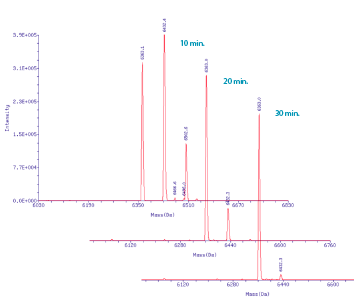Glen Report 27.13: Technical Brief - APA: An Alternative to AMA Deprotection
Back in December of 1993 in Glen Report 6.2, we reported the excellent results obtained when deprotecting oligonucleotides using AMA - a 1:1 solution of 30% ammonium hydroxide and 40% aqueous methylamine. AMA has a number of advantages over standard ammonium hydroxide deprotection, the primary advantage being the speed at which an oligo can be fully deprotected. Only 10 minutes at 65 °C is required to fully deprotect an oligo synthesized with standard protecting groups in a dry heat block and a mere 5 minutes in a 65 °C water bath.
The only caveat is that acetyl-protected dC must be used (10-1015) to prevent transamination. If the standard benzoyl-dC is used (10-1010), there is a small, but significant, amount of N-methyl-dC produced. In addition, some care must be taken to ensure that any labels or minor bases are compatible with methylamine. For example, most fluorescein analogs show sensitivity to AMA, leading to the production of a non-fluorescent impurity.1
Interestingly, despite being such a strong nucleophile, methylamine is actually more gentle on certain monomers. For example, RNA monomers, which are susceptible to loss of the 2'-O-TBDMS/TOM protecting groups in ammonium hydroxide, are much more cleanly deprotected in AMA.
In addition, AMA has the added benefit of acting as a scavenger of acrylonitrile produced in situ upon the removal of the cyanoethyl protecting groups, thereby suppressing N3-cyanoethylation of thymidine.
However, methylamine does have a downside, in that it is used as a reagent in the illicit production of methamphetamine.2 As a result, it is a DEA-regulated substance and in California additional regulatory hurdles have been implemented on the purchase and use of methylamine solutions and salts, making it difficult to procure quickly or easily.3
As a result, we investigated alternative alkylamines that are not under the DEA's list of regulated chemicals for our Californian customers. The best candidate we found was propylamine. Propylamine is a liquid at room temperature, boiling at 48 °C, and is miscible with water. However, we found that adding it directly to 30% ammonium hydroxide led to significant degassing of ammonia from the solution. To avoid this, water was added to the solution yielding the final formulation of APA as 30% ammonium hydroxide/propylamine/water 2:1:1 (v/v/v).
When evaluating the APA solution, the two criteria for its success were: 1) a reasonably short cleavage time off a standard succinyl-lcaa support; and 2) a short deprotection time without unforeseen side-reactions.
When investigating the increased cleavage rate for our Glen UnySupport FC, we determined that the standard succinyl support required a 10 minute cleavage time in AMA at room temperature for quantitative cleavage.4 The rate of cleavage of a standard succinyl support was found to be significantly slower when the APA solution was used. To obtain 97% cleavage at 20 °C, 1.5 hours was required when using APA. However, 90% of the oligo was fully cleaved in 1 hour at 20 °C (and most labs are kept above 20 °C). At 65 °C, less than 10 minutes was required.

To determine the length of time required for the APA solution to completely deprotect an oligo, a mixed-base 20mer was synthesized using standard phosphoramidites: Bz-dA, Ac-dC, iBu-dG and dT. The CPG was split and subjected to 10, 20 and 30 minutes at 65 °C in APA. The crude oligos were analyzed by electrospray MS and the deconvolved spectra are shown in Figure 1. At the 30 minute mark, the oligo was 97% deprotected, with some dG residues still retaining the isobutyryl protecting group, as shown by the +70 Da peak. Given these data, we recommend 45 minutes at 65 °C to ensure the oligo is completely deprotected. As with AMA, the APA is seen to suppress cyanoethylation with no +53 Da peaks observed.
Given these results, the APA deprotection solution has been shown to be a good substitute for AMA, albeit with slower kinetics. We hope that this information may be of assistance to our customers looking for alternative deprotection solutions that are free of methylamine.
References
- Technical Brief - Side Reaction of Fluorescein during Deprotection with Methylamine, https://www.glenresearch.com/reports/gr25-13
- Vince Gilligan et al., Breaking Bad, ep 5.05, "Dead Freight" 2012
- See: http://ag.ca.gov/bne/pdfs/laws03.pdf (pdf no longer available)
- It should be noted that the FC Linker afforded quantitative cleavage using AMA in 2 minutes. See: Technical Brief - Glen UnySupport Now Available with Fast Cleavage, https://www.glenresearch.com/reports/gr25-28
- Glen Report 27.11: Reversible Photo-Switching of DNA Function with Azobenzene-Tethered DNA
- Glen Report 27.12: New Products - Dithiol Serinol Phosphoramidite and 3’- Dithiol Serinol CPG
- Glen Report 27.13: Technical Brief - APA: An Alternative to AMA Deprotection
- Glen Report 27.14: Photocleavable Biotin Linker for Use in SOMAscan™
- Glen Report 27.15: PC Modifiers
- Glen Report 27.16: Technical Brief - Capping and Trityl-Protected Amino-Modifiers
- Glen Report 27.17: Technical Brief - DBCO-dT - An Unusual Case of Iodine Sensitivity

